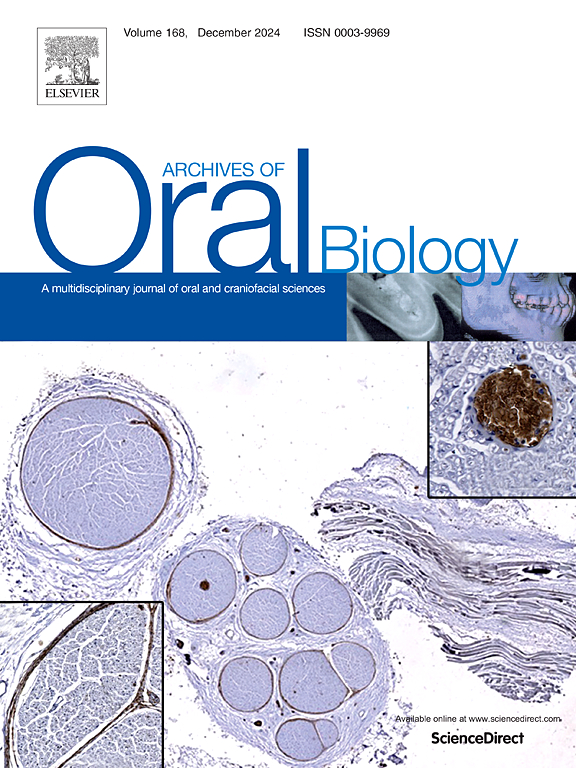Association between CpG-SNPs and nonsyndromic cleft lip palate in a Chilean population
IF 2.1
4区 医学
Q2 DENTISTRY, ORAL SURGERY & MEDICINE
引用次数: 0
Abstract
Objective
To assess the association between common variants in CpG islands (CpG-SNPs) related to the expression of selected genes, and the risk of nonsyndromic cleft lip with or without cleft palate (NSCL/P) in a Chilean sample.
Design
A total of 239 Chilean NSCL/P unrelated cases and 524 controls were genotyped using GSA array. Genotypes were imputed from the array, selecting those located within CpG islands coordinates and associated with the expression of genes differentially expressed in human cleft tissues. These selected SNPs were used for association analysis with NSCL/P based on logistic regression.
Results
A total of 96 CpG-SNP met the above-mentioned criteria. After multiple comparisons correction (p-value<0.000862), only rs12940418 remains significantly associated with NSCL/P (OR 0.644, 95 % CI 0.496–0.833, p-value=0.000859). Although this variant is located 540 Kb away from the transcription start site of SHMT1, it has evidence of modulating its expression.
Conclusions
The most plausible biological explanation for our results is cis/distal regulatory effect of rs12940418 on the expression of SHMT1. This gene encodes an enzyme implicated in folate/one-carbon metabolism, and its variants have been previously associated with NSCL/P in our population. Our results reveal the role of epigenetic mechanisms in birth defects expression such as DNA methylation and small RNAs.
智利人群中cpg - snp与非综合征性唇腭裂的关系
目的评估智利CpG岛常见基因变异(CpG- snp)与特定基因表达与非综合征性唇裂伴或不伴腭裂(NSCL/P)风险的关系。239例智利NSCL/P非相关病例和524例对照采用GSA基因分型。从该阵列中选择位于CpG岛坐标内且与人裂组织中差异表达基因表达相关的基因型进行基因型估算。这些选择的snp用于基于逻辑回归的NSCL/P相关性分析。结果共有96个CpG-SNP符合上述标准。经多次比较校正(P值<;0.000862),只有rs12940418与NSCL/P显著相关(OR 0.644, 95 % CI 0.496-0.833, P值=0.000859)。尽管该变异位于距SHMT1转录起始位点540 Kb处,但有证据表明它可以调节SHMT1的表达。结论rs12940418对SHMT1表达的顺式/远端调控是本研究结果最合理的生物学解释。该基因编码一种与叶酸/单碳代谢有关的酶,其变体先前与我们人群中的nsl /P有关。我们的研究结果揭示了表观遗传机制在出生缺陷表达中的作用,如DNA甲基化和小rna。
本文章由计算机程序翻译,如有差异,请以英文原文为准。
求助全文
约1分钟内获得全文
求助全文
来源期刊

Archives of oral biology
医学-牙科与口腔外科
CiteScore
5.10
自引率
3.30%
发文量
177
审稿时长
26 days
期刊介绍:
Archives of Oral Biology is an international journal which aims to publish papers of the highest scientific quality in the oral and craniofacial sciences. The journal is particularly interested in research which advances knowledge in the mechanisms of craniofacial development and disease, including:
Cell and molecular biology
Molecular genetics
Immunology
Pathogenesis
Cellular microbiology
Embryology
Syndromology
Forensic dentistry
 求助内容:
求助内容: 应助结果提醒方式:
应助结果提醒方式:


